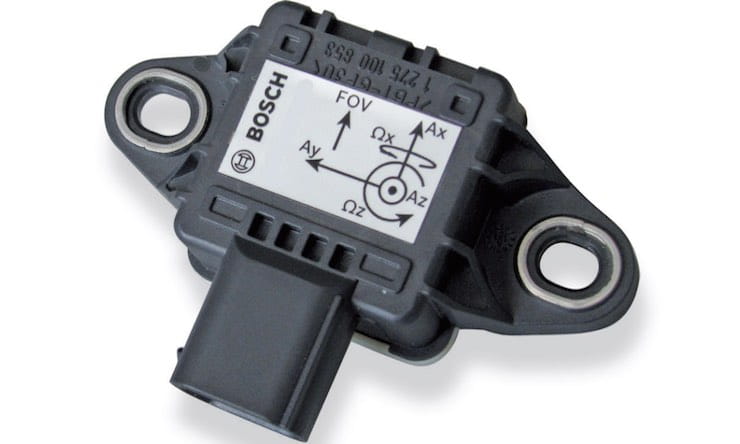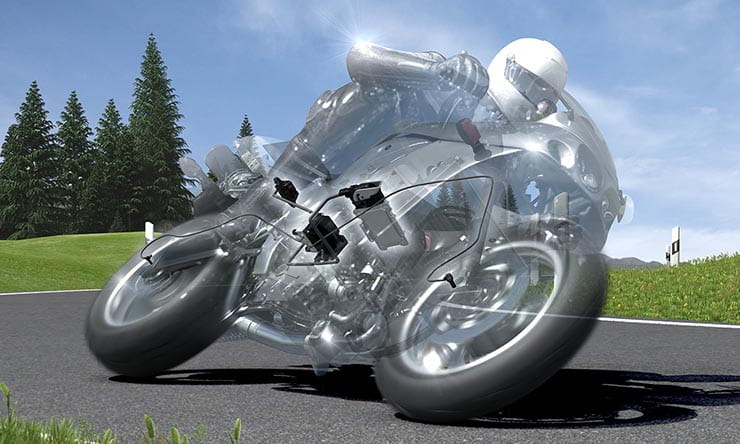The IMU is basically a single piece of electronics that combines both accelerometers and gyros to be able to measure both linear acceleration and changes in orientation. If you’ve got a smart phone, it probably already contains sensors that work in much the same way to measure its movement. By comparing these measurements against one another as well as readings from wheel speed sensors, a modern IMU-equipped bike knows precisely what’s going on at all times. It can tell if a wheel is starting to spin or to lock-up, whether both wheels are on the ground, your lean angle and even the angle that you’re wheelying at, if that’s your thing. And with the ability to influence braking pressure via the ABS and engine torque via the ignition, electronic throttles and injection, the extent of the ability to operate things like stability control, wheelie control, anti-lift systems for the rear wheel or cornering ABS all come down to the programming of the electronic brain that ties everything together.
You’ll see that IMUs are often referred to as being ‘six-axis’ or ‘five-axis’. This refers to the sensors – three accelerometers and either two or three gyros, giving a total of five or six measurements. Although we live in a 3D world, there are actually six movements that can be measured, three linear (i.e. changes in position) and three rotational (i.e. changes in orientation). The linear ones are left-right, up-down and back-forward. There are also the pitching movements as the bike angles forwards and back under acceleration or braking, the side-to-side roll as it leans and the yaw as the bike changes direction. Combined, these are referred to as the six degrees of freedom.
Mörbe explained that there are five sensors inside the latest Bosch IMU: “We are currently in the fifth generation, the MM5.10. We have three acceleration sensors, in the X, Y, and Z axis. The Z axis is vertical, the Y is left and right and the X is forwards and backwards. We also have two gyroscopes. These gyroscopes are orientated in the Z axis and either the Y or the X axis, depending on how the unit is placed on the vehicle. With a special algorithm we are able to work out the missing gyro axis, so by means of computing it’s possible to have six-degree functionality.”
So there’s a huge amount of information coming from those sensors. The next job is to apply that information to other systems so it can be helpful. Obviously two key beneficiaries are the bike’s ABS brakes and its traction control.
“The main elements are the drivetrain and the braking system,” said Mörbe, “On top of that, suspension systems can be influenced by data we receive from the sensors on the bike. That can give better adjusted suspension for the average 90 percent of motorcycle riders. My personal experience is that most of them, if they adjust their suspension at all, only do it once in the time they own the bike. They then ride it like that for the next 15,000km. They are not using the entire performance of that the suspension systems actually provide.
“So this is one of the options we have, to modify the suspension to have comfort, more stability and even up to the point of having shorter braking distances by reducing the dive of the fork and changing the rebound adjustment at the rear during braking.”
The progress that’s been made in just a handful of years is already astounding, and the adoption of these electronic systems is what makes today’s crop of new bikes stand out so much from their forebears. But there’s still more to come from the fast-improving.
Mörbe said: “What we have now, and this is a very good view into the future, is a technology which allows us to staple the micro-machine functionality on top of the amplification device, which is a micro-controller with some specific hardware. With this technology we can reduce the size of the package, to get smaller devices on the circuit board and to place more units on one circuit board. In future we will see generations with more features and more performance than the one that is currently in production.
“Technology wise, we are working on reduction in dimensions but in principle the micro-machine technology remains the same. In terms of performance, it’s always a question of what is the ultimate reference? The reference so far in the motorcycle industry is a fibre-optic sensor that works using light. It’s a fibre-optic gyro that’s used for satellites and rockets, coming from the military side. We use these as a reference, and the latest generation of sensor is very close to the reference already. The deviations we had five or six years ago are almost gone. I can say with a bit of confidence that we are close to the reference now. The sensor itself will not be the limiting factor anymore.”









